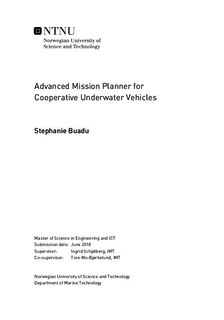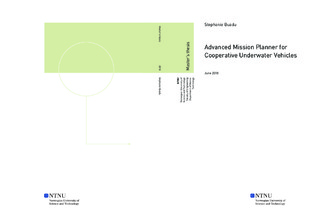| dc.description.abstract | In later years, the complexity of underwater missions has increased, resulting in a growing interest in cooperative Autonomous Underwater Vehicle (AUV) systems. When executing a complex mission, cooperative systems are superior to a single vehicle, and mission planning and formation control are two components that contribute to this superiority. Despite the growing interest in the field, published literature on formation control of AUVs is for the most part based on theoretical research, and there is a lack of published experiments and practices.
A literature study on mission planning and cooperative underwater systems was conducted to gain knowledge about the fields. Basic concepts of mission planning and the challenges associated with mission planning for AUV were reviewed in addition to state-of-the-art applications for cooperative systems, and the formation control problem. The motivation for this thesis was to contribute to the research in the fields of cooperative AUV systems, and this was achieved by implementing a desktop application with mission planning and formation control functionality for a cooperative AUV system.
The application is named the MCS (Mission Control System) and provides an operator with a user interface for connecting to a system of Light Autonomous Underwater Vehicles (LAUVs), defining a mission plan, and monitoring and controlling mission execution. The application also functions as a framework for testing formation control methods. The MCS functions both standalone and as an integrated part of the command and control software offered in the Underwater System and Technology Laboratory (LSTS) toolchain. Verification of the software included evaluating system requirements and comparison to existing command and control software. Simulations and field tests demonstrated the application's performance and proved it to be robust in both environments. Based on observations made during verification and testing, suggestions were made to enhance the application.
An algorithmic formation control method with properties from leader-follower systems, virtual structures, and behavior-based formation control was designed. Each vehicle in the team is assigned as either master or slave, and the method further relies on the vehicles maneuvering predetermined paths simultaneously. Four cooperative strategies are in place to restore the formation if deviations occur. The method was verified through simulations and field experiments.
The experimental verification method entailed controlling a cooperative system consisting of LAUV Fridtjof in combination with LAUV simulators, and field tests were conducted on the surface in the Trondheim Fjord. Simulation and field test results proved the designed formation control method to be valid. The vehicle teams were able to complete missions and restore the formation when constraint violations occurred. Based on the observations made, suggestions for improving the method and making it more robust against external forces acting on the vehicles were given. Results imply that further testing should be carried out to validate the method's performance on a larger scale and with multiple physical vehicles. Before this can be done, collision avoidance should be implemented. | |

